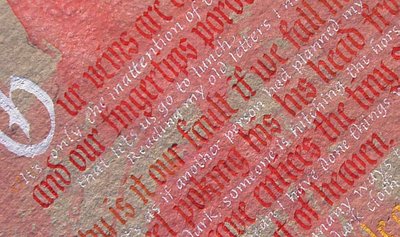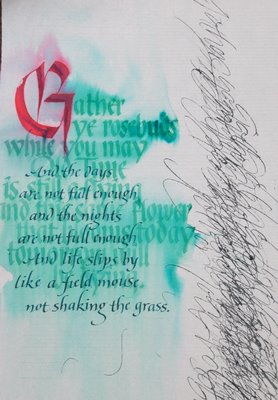

Doyal Lewis was a friend of mine when I lived in Decatur, in the late '80's to mid '90's, when he died of cancer. I could never invent a more Southern Character. He was raised somewhere in north Georgia on a farm, one of many children. As soon as he was old enough he escaped to a more urban life. He had been in the military and always appreciated it when someone sent him a card for Veterans Day honoring his service.
I knew him late in his life, when he was retired from his teaching job and had been with his partner, Charles, for over 40 years. I used to hang out at their house, for Doyal was a consumate teacher and always wanted to show me--or anyone--what he was up to. At this time of my life I was between jobs and only lived a few blocks away; I could easily walk over and stay for hours. He had had a fabulous studio built to house his elaborate silkscreen operation. He sold silkscreened cards of his calligraphy at a few shops around the city. They'd occasionally invite me to stay for supper, which was nice as my new husband's schedule at the newspaper meant he never got home before 10pm.
At Friends of the Alphabet meetings he always had a smile on his face and a twinkle in his eye. Everyone seemed pleased to see him, but not everyone liked him. He was full of jokes and witticisms, many so arcane they missed me entirely. He was also full of stories of growing up in Georgia, or the good life he lived with Charles in their grand house in Atlanta. Often the stories involved people long dead and wound all over with many asides, and it was a struggle to keep up, especially with his slow, drawling accent.
He affected to take me under his wing, I think, and advise me on the ways of the world. For I was hopelessly naive and ignorant. He brought me with him once to the the italic class he taught at Dekalb College, for he had decided to groom me to take over for him (although I didn't know this at the time). His world view involved layers of intrique and political sleight-of-hand among his friends and acquaintances. He spoke of our calligraphy guild, Atlanta Friends of the Alphabet, and the power struggle between the young and the old (which I never did see). He seemed to think the young were trying to wrest power from the old, but the old would never give it up. And now all the old of which he spoke are dead and gone. Or very nearly.
He surprised us all by having a poster printed up (25" x 33") of a bunch of quotations and words about the state of Georgia and Atlanta to sell to make a 'little money.' It was a high quality poster on heavy paper, and I still have mine. He really needed to have teamed up with an illustrator though, for the shape of Georgia itself is blank, and a huge blankness it is! But he had that kind of tenacity where he could sit for hours lettering. He said he took up calligraphy when Charles became so ill, and he had to wile away the midnight hours somehow as he stood watch and nursed him.
I eventually found a job and we bought a house a few miles away. I was busy between the fixing-up of the house and the new job, so I didn't see Doyal much anymore, and it came as a shock to hear he'd been diagnosed with cancer just months after Charles' death. Even more of a shock was his own death just two months later. He's been gone now for eleven years. I put the poster up here, with a detail, in memory of Doyal.



























